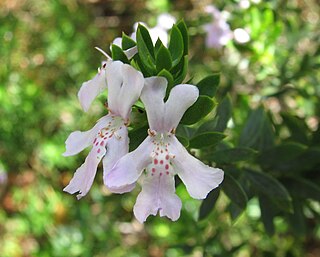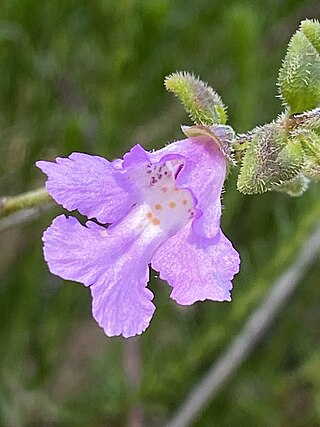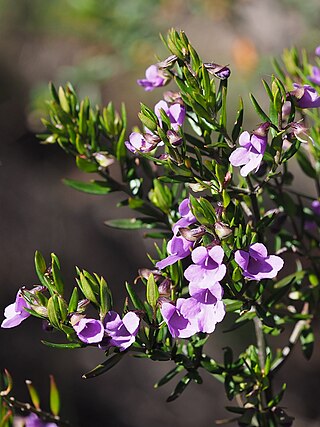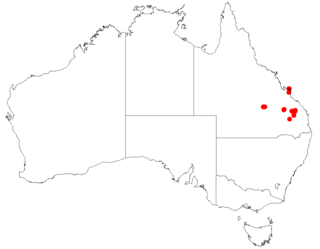
Prostanthera incisa, commonly known as cut-leaf mint-bush or native thyme, is a species of flowering plant in the family Lamiaceae and is endemic to south-eastern continental Australia. It is an erect, strongly aromatic, openly branched shrub with hairy, densely glandular branches, egg-shaped to oblong leaves, and pale mauve to mauve flowers.

Prostanthera rotundifolia, commonly known as round-leaved mintbush or round-leaf mint-bush is a species of flowering plant in the mint family Lamiaceae, and is endemic to south-eastern Australia. It is an erect shrub with aromatic branches covered with short hairs and glands, egg-shaped to more or less round leaves and purple to mauve or pinkish flowers on the ends of branchlets.

Prostanthera ovalifolia, commonly known as the oval-leaf mintbush or purple mintbush, is a species of flowering plant in the family Lamiaceae and is endemic to south-eastern continental Australia. It is an erect shrub with egg-shaped leaves and groups of mauve to deep blue-purple flowers arranged in groups at the ends of branchlets.

Westringia glabra, commonly known as violet westringia, is a flowering plant in the family Lamiaceae and is endemic to Australia. It is a small shrub with oval-shaped leaves and pinkish, mauve or purple flowers.

Prostanthera marifolia, commonly known as Seaforth mintbush, is a species of flowering plant that is endemic to a restricted area of New South Wales. It is a small, erect, openly branched shrub with egg-shaped to elliptic leaves, and purple to mauve flowers arranged in leaf axils.

Prostanthera rhombea, commonly known as sparkling mint-bush, is a plant in the family Lamiaceae and is endemic to disjunct areas of south-eastern Australia. It is an openly-branched shrub with strongly aromatic branches, circular to heart-shaped leaves and mauve or bluish flowers.

Prostanthera denticulata, commonly known as rough mint-bush, is a species of flowering plant in the family Lamiaceae and is endemic to coastal New South Wales. It is a straggling to almost prostrate, aromatic shrub with narrow egg-shaped leaves and purple to mauve flowers arranged in leaf axils or on the ends of branchlets.

Prostanthera saxicola is a species of flowering plant in the family Lamiaceae and is endemic to eastern Australia. It is a shrub with linear to elliptic leaves and white to mauve flowers arranged in leaf axils.

Prostanthera serpyllifolia, commonly known as small-leaved mint-bush, is a species of flowering plant in the family Lamiaceae and is endemic to southern Australia. It is a small shrub with small egg-shaped leaves and bright pink to red or metallic bluish-green flowers.

Prostanthera caerulea, commonly known as lilac mint bush, is a species of flowering plant that is endemic to eastern Australia. It is an erect shrub with narrow egg-shaped leaves that have toothed edges, and white to bluish mauve flowers arranged on the ends of branchlets.

Prostanthera prunelloides is a species of flowering plant in the family Lamiaceae and is endemic to eastern New South Wales. It is a shrub with four-ridged branches, egg-shaped to round leaves and white or pale mauve flowers.

Prostanthera scutellarioides is a species of flowering plant that is endemic to New South Wales. It is an erect, or low-lying, faintly aromatic shrub with linear leaves and pale to deep mauve flowers arranged in leaf axils.

Goodenia pilosa is a species of flowering plant in the family Goodeniaceae and is native to northern Australia and to parts of Asia. It is a prostrate to low-lying herb with erect hairs, narrow oblong to narrow elliptic leaves at the base of the plant and racemes of yellow flowers with a purplish base.
Goodenia pumilio is a species of flowering plant in the family Goodeniaceae and is native to northern Australia and New Guinea. It is a prostrate, stolon-forming herb with egg-shaped to lance-shaped leaves in rosettes, and racemes of small, dark reddish-purple flowers.

Leucopogon muticus, commonly knwon as blunt beard-heath, is a species of flowering plant in the heath family Ericaceae and is endemic to eastern Australia. It is an erect, straggling shrub with egg-shaped leaves with the narrower end towards the base, and small numbers of white, tube-shaped flowers that are densely bearded inside.

Leucopogon cuspidatus is a species of flowering plant in the family Ericaceae and is endemic to the central Queensland coast. It is a shrub with densely hairy young branchlets, egg-shaped to lance-shaped leaves with the narrower end towards the base, and white, bell-shaped flowers that are bearded inside.

Pimelea argentea, commonly known as silvery leaved pimelea, is a species of flowering plant in the family Thymelaeaceae and is endemic to the south-west of Western Australia. It is an erect shrub with densely hairy young stems and leaves, the leaves linear to elliptic, and heads of white to yellow or greenish flowers, the male and female flowers on separate plants.
Pimelea cinerea is a species of flowering plant in the family Thymelaeaceae and is endemic to Tasmania. It is a slender shrub with more or less elliptic leaves, and heads of white flowers surrounded by leaves.

Leucopogon flexifolius is a species of flowering plant in the family Ericaceae and is endemic to south-east Queensland. It is a rigid shrub with many softly-hairy branchlets, crowded, sharply-pointed linear to lance-shaped leaves, and small, white, bell-shaped flowers that are bearded inside.

Leucopogon glabellus is a species of flowering plant in the family Ericaceae and is endemic to the south-west of Western Australia. It is an erect, glabrous shrub with slender branchlets, heart-shaped to lance-shaped leaves, and cylindrical spikes of white flowers.



















